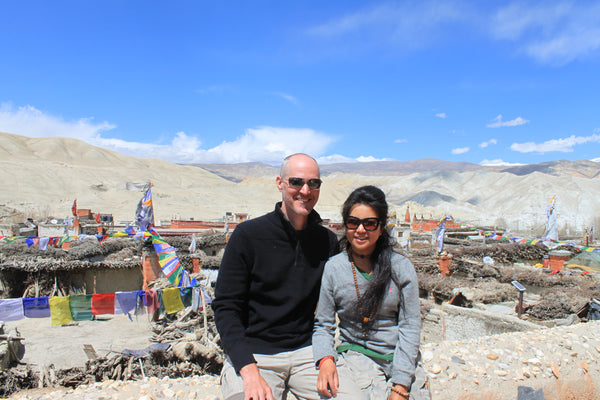Our Story
For centuries, traders have journeyed over high Himalayan mountain passes and along well-worn paths through the desolate Tibetan deserts. They carried not just goods, but religion, arts and customs. Over centuries, these influences spread throughout the entire Himalayan region and beyond. Today, as you look at art in monasteries, thangka paintings, Buddhist sculptures, antique Tibetan rugs, handmade jewelry, embroidered cashmere scarves, and ornate textiles and clothing a story of these influences can be told. In this way, these arts tell the story of the Himalaya.

Mahakala Fine Arts started quite unexpectedly. Stephen had been working as an expatriate in Asia for the better part of a decade. Meanwhile, Candice lived in Shanghai and owned a popular jewelry shop. After dating for several years, we decided to leave that life behind, get married and go on an 8-month honeymoon. We travelled through India, joining a yoga program for two weeks in Rishikesh and following the Dalai Lama for a week, hearing his words of compassion every day. We then went to Nepal where we took a ten-day course on Buddhism at a mountaintop Tibetan monastery. We woke every day before sunrise to start our daily meditations. We explored the Nepali countryside and went trekking through the wild restricted Mustang area (see photo, in Lo Manthang) along the desolate border with Tibet. We also journeyed to Bhutan where we climbed to the Tiger's Nest monastery, and enjoyed the fabulous Paro Tsechu where we had the honor of meeting the lovely King and Queen.
Upon returning from our honeymoon, we decided to follow this new direction in our lives. We opened a charming boutique in Shanghai's famous Tianzifang tourist neighborhood carrying Himalayan jewelry and handmade cashmere scarves that Candice had collected on our honeymoon, along with a few antique Tibetan rugs.
The response from customers was overwhelming and soon Candice returned to Nepal on a shopping trip. Unfortunately, she was caught in the April 25, 2015 earthquake. She called me in the seconds after the shaking stopped to tell me about what had happened. Fortunately she was okay, but for a week she witnessed the destruction and despair while she waited for passenger flights to resume. We wanted to help so we partnered with our friend and master Nepali artist, Mukti Singh Thapa, to sell prints of two of his most meaningful thangka paintings to raise money for the relief efforts. Given the incredible response to his art, we decided to open an art gallery on our 2nd floor, and started an exhibition with thirteen of Mukti's works. We added internationally acclaimed artists Udaya Charan Shrestha and Lok Chitrakar and our collection has grown to over sixty works by Nepal's top three traditional artists. In order to continue our efforts to support those most in need in the Himalaya, we sponsor two young girls through the NGO Save The Children, using funds from every print we sell.
As we have traveled the Himalaya we have fallen in love with the textiles of the region...their striking colors, myriad designs, and varying techniques. Each region has a different specialty that they have mastered over the centuries and passed down from generation to generation. What is wonderful about India is that these arts are still alive, although they are quickly being taken over by technology. In order to help keep the traditional arts alive, we have recently opened our own studio in India and make luxurious handmade clothing, bags and other accessories. We use handmade dyeing techniques such as shibori, dabu and bandhani and organic dyes including indigo, turmeric and madder to create magical cloth. Inspired by the delightful design motifs of the Himalaya we create a line of clothing that has a relaxed and modern sensibility.
We started Mahakala Fine Arts to share our inspiration and introduce the work of the finest artisans in the region...painters, silversmiths, weavers, fabric designers and more. We travel to the Himalaya to source and create all of our products. Sometimes we trek into the countryside to find special items, other times we use our extensive network to find the most unique items, and more recently we started designing and making our own line of clothing. In this way we can always carry distinctive handmade products and we can also ensure that we are making a positive impact on the community.
Each piece in our collection tells a story. We welcome you to join us as our journey continues.




